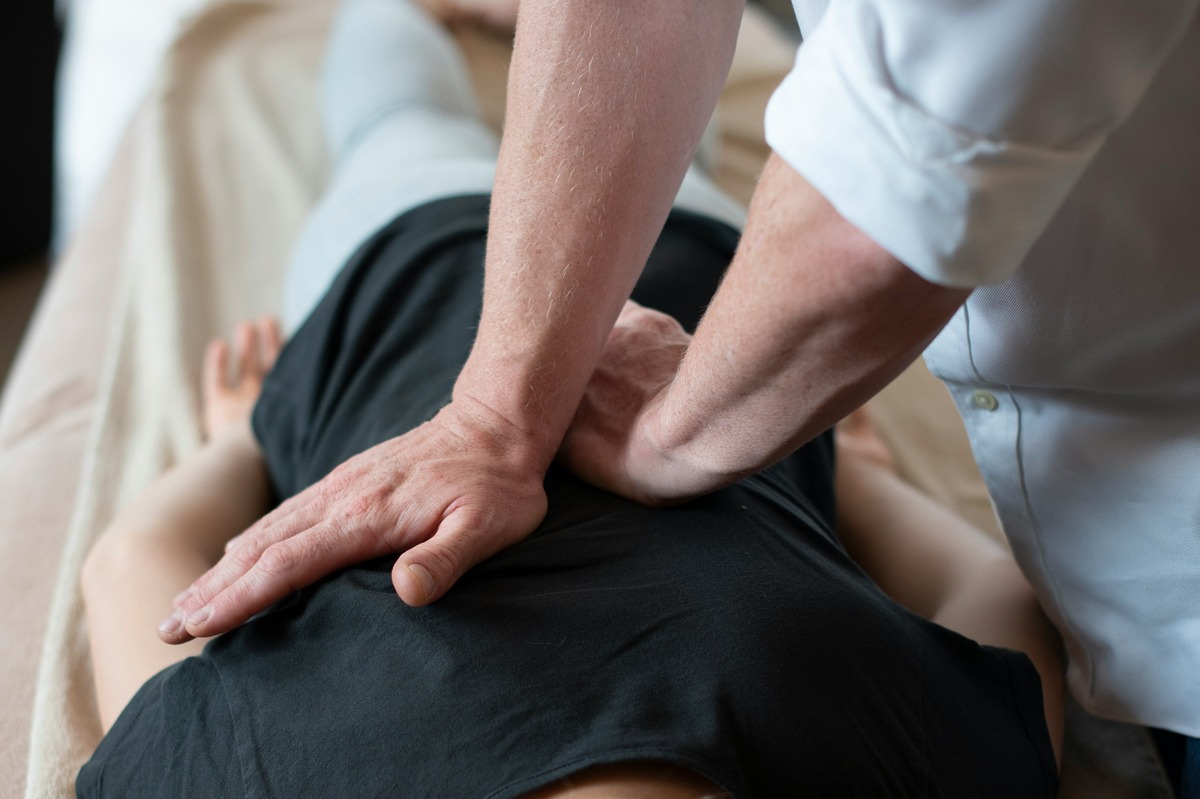Spinal Manipulation and Mobilization
Spinal Manipulation and Mobilization
Empowering Movement, Restoring Freedom
Schedule a FREE Discovery Call!
Controlled force applied to the spine to reset joints and soft tissue receptors.
What Is Spinal Manipulation and Joint Mobilization?
Spinal manipulation and joint mobilization are similar treatments that can help improve the function of a joint. Despite the word “spinal,” both manipulation and mobilization can be used on multiple joints of the body.
The purpose of these treatments are to reduce pain, improve range of motion and muscle activation, and reduce stiffness of the targeted joints. Although spinal manipulation and joint mobilization can fall under the same umbrella and provide significant therapeutic benefits, they involve different manual therapy techniques performed by the provider based on the patient’s clinical presentation.

Joint mobilization is a technique that utilizes slow and controlled oscillating movements, which can vary in direction and depth depending on the patient’s condition and the specific goals of treatment. It is a gentle movement that improves the range of motion of a joint, reduces pain and promotes healing. Mobilization can be very helpful as a preparation for spinal or joint manipulation, as it allows relaxation of tissues and muscles that may be guarded.
Joint mobilization increases synovial fluid and blood flow, which lubricates the joints and relaxes the surrounding tissues; this allows for a more targeted manipulation. For patients who may not be able to tolerate the high-velocity “thrusts” that are involved with manipulation due to pain or muscle guarding, mobilization may be a better fit when beginning hands-on treatments.
Spinal manipulation (or joint manipulation) is a technique in which a provider uses their hands to perform a “thrust” maneuver to a targeted area on the body. It is a very specific and controlled technique that is completed quickly, but over a very short distance.
This high-velocity, low-amplitude technique is performed at the end range of the joint’s movement using combined levers (combination of side-bending, side gliding, and rotation), which minimizes the amount of force required and may or may not result in a popping sound. This sound is not necessary to gain benefits from this treatment, and is theorized to be small gas bubbles being released from your joints. The purpose of manipulation is to reset the joint and soft tissue receptors, which induces relaxation, improves range of motion, and allows for more muscle recruitment.
You may recognize these treatments as something commonly provided by chiropractors (known as chiropractic adjustments). The good news is that these treatments are not limited to chiropractors, as the physical therapists at Hive Therapy and Wellness are extensively trained in spinal and joint manipulation therapy. This is fantastic news for patients! Not only will they get the acute pain-relieving and improved mobility benefits from manipulation therapy, but they will also be given an individualized home exercise program to help maintain the results between sessions. This unique combination of hands-on therapy and exercise prescription will help you reach your goals faster and it is what sets Hive Therapy and Wellness apart from the rest.
Who Can Benefit From These Treatments?
Patients with joint pain or motion restrictions can benefit from spinal manipulation or joint mobilization. Although commonly thought to treat exclusively the spine, hips, or pelvis, these techniques are also suitable for pain in other parts of the body; such as the neck, shoulders, elbows, hands, back, knees, ankles, and feet.
These techniques allow for an improved joint range of motion, decreased pain, and better activation of certain muscles or inhibition of other muscles. This results in improved muscular balance and coordination, and allows patients to perform specific movements and activities with more ease. Those who may be experiencing a loss of movement from an injury or surgery can benefit from joint mobilizations or spinal manipulation to regain normal motion.
What to Expect From These Treatments
You will always be screened for contraindications before receiving spinal manipulation or joint mobilization. Some contraindications include rheumatoid arthritis, osteoporosis, fractures, dislocations, or infections within the treatment area. If no contraindications are present, your provider will evaluate your condition to see if either spinal manipulation or joint mobilization is suitable.
This includes an examination of your pain, current range of motion, motor control, and tissue tone. After the evaluation is complete and your therapist deems the treatment suitable, they will perform the procedure with your consent. After your physical therapist performs the treatment, they will discuss and demonstrate to you any immediate improvements.
At Hive Therapy and Wellness, we make sure to always gain proper consent from our patients before performing these techniques. Our expert physical therapists will provide you with a thorough explanation of the treatment, as well as prescribe at-home exercises or movements necessary for you to practice.
This exercise prescription is incredibly important for all patients, not only to help make any post-treatment soreness more manageable, but also to maintain the gains and progress from the in-session treatment. Patients are encouraged to continue moving, exercising, stretching, and hydrating after their session for these reasons. Soreness should not persist for more than 24 – 48 hours. To further minimize soreness, the provider may suggest the use of ice or heat therapy as well.
Spinal manipulation and joint mobilization are similar treatments that can help improve the function of a joint. Despite the word “spinal,” both manipulation and mobilization can be used on multiple joints of the body.
The purpose of these treatments are to reduce pain, improve range of motion and muscle activation, and reduce stiffness of the targeted joints. Although spinal manipulation and joint mobilization can fall under the same umbrella and provide significant therapeutic benefits, they involve different manual therapy techniques performed by the provider based on the patient’s clinical presentation.
Joint mobilization is a technique that utilizes slow and controlled oscillating movements, which can vary in direction and depth depending on the patient’s condition and the specific goals of treatment. It is a gentle movement that improves the range of motion of a joint, reduces pain and promotes healing. Mobilization can be very helpful as a preparation for spinal or joint manipulation, as it allows relaxation of tissues and muscles that may be guarded.
Joint mobilization increases synovial fluid and blood flow, which lubricates the joints and relaxes the surrounding tissues; this allows for a more targeted manipulation. For patients who may not be able to tolerate the high-velocity “thrusts” that are involved with manipulation due to pain or muscle guarding, mobilization may be a better fit when beginning hands-on treatments.
Spinal manipulation (or joint manipulation) is a technique in which a provider uses their hands to perform a “thrust” maneuver to a targeted area on the body. It is a very specific and controlled technique that is completed quickly, but over a very short distance.
This high-velocity, low-amplitude technique is performed at the end range of the joint’s movement using combined levers (combination of side-bending, side gliding, and rotation), which minimizes the amount of force required and may or may not result in a popping sound.
This sound is not necessary to gain benefits from this treatment, and is theorized to be small gas bubbles being released from your joints. The purpose of manipulation is to reset the joint and soft tissue receptors, which induces relaxation, improves range of motion, and allows for more muscle recruitment.
You may recognize these treatments as something commonly provided by chiropractors (known as chiropractic adjustments). The good news is that these treatments are not limited to chiropractors, as the physical therapists at Hive Therapy and Wellness are extensively trained in spinal and joint manipulation therapy.
This is fantastic news for patients! Not only will they get the acute pain-relieving and improved mobility benefits from manipulation therapy, but they will also be given an individualized home exercise program to help maintain the results between sessions. This unique combination of hands-on therapy and exercise prescription will help you reach your goals faster and it is what sets Hive Therapy and Wellness apart from the rest.
Patients with joint pain or motion restrictions can benefit from spinal manipulation or joint mobilization. Although commonly thought to treat exclusively the spine, hips, or pelvis, these techniques are also suitable for pain in other parts of the body; such as the neck, shoulders, elbows, hands, back, knees, ankles, and feet.
These techniques allow for an improved joint range of motion, decreased pain, and better activation of certain muscles or inhibition of other muscles. This results in improved muscular balance and coordination, and allows patients to perform specific movements and activities with more ease. Those who may be experiencing a loss of movement from an injury or surgery can benefit from joint mobilizations or spinal manipulation to regain normal motion.
You will always be screened for contraindications before receiving spinal manipulation or joint mobilization. Some contraindications include rheumatoid arthritis, osteoporosis, fractures, dislocations, or infections within the treatment area. If no contraindications are present, your provider will evaluate your condition to see if either spinal manipulation or joint mobilization is suitable.
This includes an examination of your pain, current range of motion, motor control, and tissue tone. After the evaluation is complete and your therapist deems the treatment suitable, they will perform the procedure with your consent. After your physical therapist performs the treatment, they will discuss and demonstrate to you any immediate improvements.
At Hive Therapy and Wellness, we make sure to always gain proper consent from our patients before performing these techniques. Our expert physical therapists will provide you with a thorough explanation of the treatment, as well as prescribe at-home exercises or movements necessary for you to practice.
This exercise prescription is incredibly important for all patients, not only to help make any post-treatment soreness more manageable, but also to maintain the gains and progress from the in-session treatment. Patients are encouraged to continue moving, exercising, stretching, and hydrating after their session for these reasons. Soreness should not persist for more than 24 – 48 hours. To further minimize soreness, the provider may suggest the use of ice or heat therapy as well.


